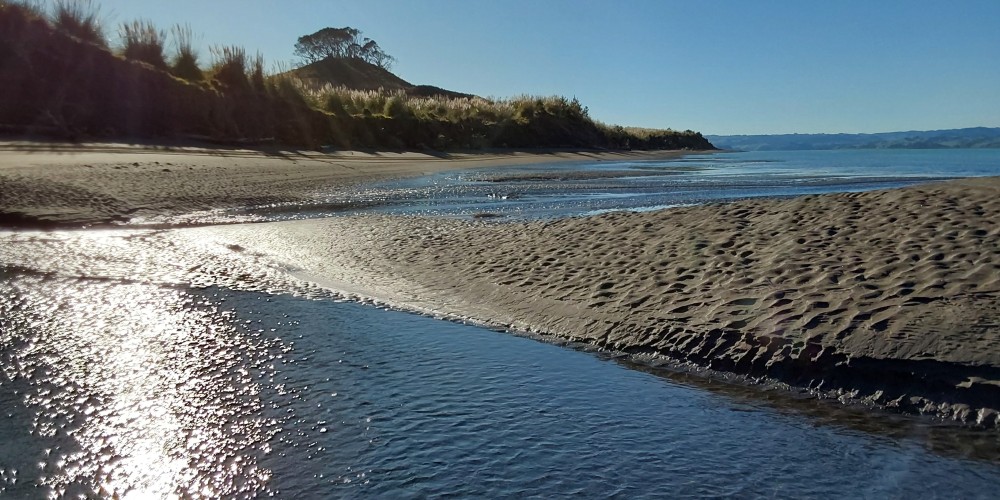
Access to Kāwhia beach via the boat ramp has been an ongoing issue for many years (and to a lesser extent, beach access via Aotea). This page summarises the issue and what Council is doing.
Quick links - Alternate Access Feasibility documents
So, what’s the issue?
There are several issues at play. Vehicles on beaches provide recreational access, which comes with pros and cons.
As long as drivers abide by good practices, having access to the beach can provide many recreational and wellbeing benefits. However, we are seeing an increase in some bad behaviour and poor judgements leading to:
-
damage to sensitive environments
-
“hooning” on the beach
-
vehicles being taken on the beach that are not designed for that use
-
vehicles getting stuck
There is often debate and strongly held beliefs (especially on social media) as to whether the damage is from locals or visitors. Regardless of where the driver or vehicle is from, it is the poor decisions and bad behaviour of individuals which is causing the problems – rather than where they are from.
This issue is not unique to Kāwhia, and often plays out at vehicle-access beaches around Aotearoa with strongly divided communities (for and against).
What are the rules?
The Kāwhia/Aotea coastal foreshore is a highly complex area to manage, involving multiple agencies, multiple bits of legislation and owners of Māori land.
Ōtorohanga District Council - Road Controlling Authority
-
All beaches are classified as legal roads under the Land Transport Act, unless restricted by local bylaws.
-
ŌDC allows vehicle access on the Kāwhia beach under our Traffic Management Bylaw.
-
Under this bylaw:
-
Traffic is limited to 20kph.
-
The “beach” (the area below high tide) is classified as a legal road in the Land Transport Act.
-
Normal road rules apply.
-
-
Importantly, ŌDC does not have any powers to enforce breaches of the bylaw.
-
As a legal road, NZ Police have the powers and responsibility for enforcing breaches of speed or driver behaviour.
-
Any observations of unsafe driving or breaches of the 20kph limit should be reported directly to NZ Police.
Waikato Regional Council - Environmental Management
-
WRC manages adverse effects on the environment.
-
Below high tide, WRC enforces their Regional Coastal Plan.
-
Above high tide, WRC rules under their Regional Plan apply.
-
Issues include:
-
Damage to sensitive ecological or heritage areas
-
Discharges (e.g. oils and fluids from stuck vehicles)
-
-
Any observations of environmental damage should be reported directly to WRC.
Landowners
-
Māori land titles extend down into the “hard sand area” where drivers typically prefer to drive.
-
Under the Marine and Coastal Areas (Takutai Moana) Act 2011, there is no legal right of vehicle passage across these titles – but there is right of general public (non-vehicular) access.
Coast Care Groups
-
Community-led voluntary organisations enhancing coastal ecology.
-
No statutory powers, but play an important role through volunteer work.
Note: Terms like the “Queens Chain” or “Kings Chain” are obsolete. These were replaced in 1991 by esplanade provisions under the RMA and coastal public access under the Marine and Coastal Areas Act. There is no legal “Kings Chain.”
What is being done?
Following a well-attended public meeting on beach access held at Kāwhia on 13th February 2025, the Kāwhia Community Board endorsed a 3-stage approach:
Stage 1: Signage
-
Install better informational signs to inform drivers of the risks of getting stuck.
-
Status (Sept 2025): In progress. A sign has been designed, location is confirmed, installation to occur in spring 2025.
Stage 2: Alternate Access Feasibility
-
Investigate the feasibility of alternate access through Tainui Kāwhia Incorporated forestry land, from Tom French Reserve (offered by TKI).
-
Status (Sept 2025): Consultant feasibility report received August 2025.
-
ŌDC is working with TKI on the report findings.
-
ŌDC staff will workshop the report with Kāwhia Community Board on 2 October 2025, and will report to the new Council for a decision on next steps in Dec 2025 or Feb 2026.
-
Click on the relevant link to find a copy of the of the report, design and costings.
Stage 3: Review Traffic Management Bylaw
-
Review the bylaw if appropriate, depending on feasibility outcomes.
-
Status (Sept 2025): Awaiting decisions from Council and TKI.
-
If alternative access is confirmed (and all consents obtained), and the bylaw is amended, ŌDC must follow a full public consultation process open to all.
Project timeframes (indicative, subject to change)
-
Go/no-go decision: Dec 2025 or Feb 2026
-
Funding approved (if go): June 2026
-
Public access easement: late 2026
-
Resource consents (WRC and ŌDC): late 2027
-
Bylaw amendment, consultation, decision: 2027/28
-
Physical works: 2028
-
Project complete: mid-2028
As this is such a complex area, it cuts across several of Council’s core functions. For any queries, please contact Council through the usual way, and we will allocate to the right person for follow up. You can find all information relating to this on our project page.
More News

WATER AND WASTEWATER PIPE REPLACEMENT WORKS – MAIN NORTH ROAD AND SURROUNDING AREAS

THE FADE UP PREMIERE - OUR TOWN, OUR STORIES, OUR WIN!

3D PrintQuest Summer Reading Challenge
HE POROPOROAKI AROHA KI A ELLE FREESTONE - a heartfelt farewell to Elle Freestone

Heather Leonard Exhibition
